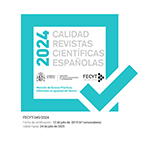Los arcedianatos y arciprestazgos como instrumentos de consolidación del poder episcopal y afirmación territorial de la diócesis de Burgos (siglos XI-XIV)
Resumen
La sede episcopal de Burgos ofrece un modelo de creación de una nueva diócesis en un contexto de existencia de varias sedes episcopales de límites fluidos que son unificadas por decisión regia en una sola cabecera diocesana (1075), que se convertirá también en capital política de facto del joven reino de Castilla. Entre el siglo XI y el XII vemos a los obispos actuar como agentes de la política eclesiástica de los monarcas castellanos y como señores que van adquiriendo patrimonio en determinadas áreas de lo que, desde finales del siglo XI, serán los límites definitivos de las diócesis. Esta contribución persigue arrojar luz sobre la aparición y evolución hasta el siglo XIV de las divisiones intradiocesanas (arcedianatos y arciprestazgos) que contribuyeron a la afirmación territorial e institucional del obispo y su colegio de clérigos. Para ello, es preciso revisar la cronología y definir la evolución del significado de las figuras del arcediano y del arcipreste, las cuales parecen haber precedido a la delimitación de sus espacios de actuación desde finales del siglo XI. Solo desde esta base de partida, se podrá avanzar en la comprensión del papel que jugaron estas figuras en la construcción de la diócesis de Burgos.
Descargas
Descarga artículo
Licencia
La revista En la España Medieval, para fomentar el intercambio global del conocimiento, facilita el acceso sin restricciones a sus contenidos desde el momento de su publicación en la presente edición electrónica, y por eso es una revista de acceso abierto. Los originales publicados en esta revista son propiedad de la Universidad Complutense de Madrid y es obligatorio citar su procedencia en cualquier reproducción total o parcial. Todos los contenidos se distribuyen bajo una licencia de uso y distribución Creative Commons Reconocimiento 4.0 (CC BY 4.0). Esta circunstancia ha de hacerse constar expresamente de esta forma cuando sea necesario. Puede consultar la versión informativa y el texto legal de la licencia.
La revista En la España Medieval no cobra por tasas por envío de trabajos, ni tampoco cuotas por la publicación de sus artículos.












